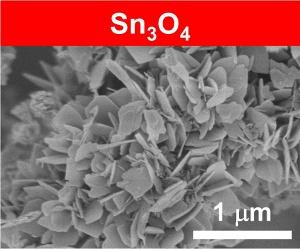 A cheap, aboundabt photocatalyst for hydrogen production discovered. (Credit: Flickr @ Martin Abegglen https://www.flickr.com/photos/twicepix/)
A cheap, aboundabt photocatalyst for hydrogen production discovered. (Credit: Flickr @ Martin Abegglen https://www.flickr.com/photos/twicepix/)A research group at Japan Science and Technology Agency (JST) led by the principal researcher Hideki Abe and the senior researcher Naoto Umezawa at the NIMS’s Environmental Remediation Materials Unit discovered a new photocatalyst, Sn3O4, that uses sunlight to produce hydrogen from water.

Electron microscope imagery of Sn3O4 catalyst. The synthesized material is a collection of microsized (one millionth of a meter) flaky crystals. (Credit: National Institute for Materials Science)
Many water-splitting photocatalysts, such as titanium dioxide (TiO2), can decompose water and produce hydrogen fuel when absorbing ultraviolet light. However, due to their inability to absorb visible light, which accounts for more than half of solar energy, their practical use in the conversion of solar energy is limited. While the development of new photocatalysts that are able to split water by absorbing visible light has been worked on globally, there are cost- and environment-related issues because many of the available photocatalysts contain expensive rare metals, such as tantalum, or high concentrations of lead, which is very toxic.
A new low-toxic photocatalyst was discovered through integrating both theoretical and experimental sciences. Scientists searched for oxides containing divalent tin ions (Sn2+) based on the theoretical prediction that such substances may have an electronic structure conducive to water-splitting photocatalytic reactions under the presence of visible light. As a result, they found a tin oxide, Sn3O4 (Sn2+2Sn4+O4), that is made up of divalent tin ions (Sn2+) and tetravalent tin ions (Sn4+). The experiment revealed that this substance facilitates a water-splitting reaction leading to the generation of hydrogen when exposed to visible light which does not activate TiO2.
Since tin oxides are relatively non-toxic, inexpensive and abundant, they are widely used as transparent conductive materials. The discovery of the Sn3O4 catalyst is expected to greatly contribute to the reduction of environmental load and costs associated with hydrogen fuel production, and to the realization of a recycling-oriented society founded on the use of solar energy.
The results of this research will be published in the near future in the online version of Applied Materials & Interfaces, a journal issued by the American Chemical Society.
Manikandan, M., Tanabe, T., Li, P., Ueda, S., Ramesh, G., Kodiyath, R., Wang, J., Hara, T., Dakshanamoorthy, A., Ishihara, S., Ariga, K., Ye, J., Umezawa, N., & Abe, H. (2014). Photocatalytic Water Splitting under Visible Light by Mixed-Valence SnOACS Applied Materials & Interfaces, 6 (6), 3790-3793 DOI: 10.1021/am500157u
